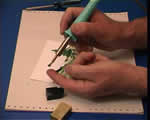 |
The stylus wire brush head is made to operate at low heat. The collection
of fine copper wires are crimped into a brass rod which slides into the
heating element of the stylus.
This is a fragile tip and needs to be treated with care or the wire fibres
will become bent and tangled, making it far less useful.
|
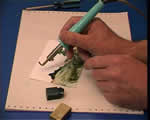 |
One difference between this brush and a regular hair brush is that the
metal fibres bend and stay where they are bent to.
You can always straighten them up again, and sometimes, if you want a
very thin brush, it can be handy to bend some of the fibres out of the
way.
|
 |
Loading the brush head with small amounts of colour is achieved by gently
placing the wire ends onto the wax block and allowing them to slowly melt
into the wax intheir own time.
Stabbing them into the wax will just destroy the wire fibres and wreck
the brush head
|
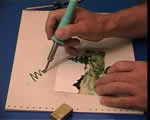 |
Once loaded the brush is best used in a 'trailing' manner wiht a very
light contact pressure. remember that pressing too hard willl bend the wire
fibres. |
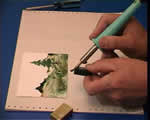 |
For bigger amounts of wax it is quicker and easier to rest the 'heel'
of the brush, where the brass rod ends, into the wax block. This melts the
wax much faster and floods the wire head until it is completely full. |
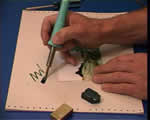 |
A brush head filled with wax behaves much like a 'wet' watercolour brush,
and the wax paint will flood off onto the painting surface very quickly,
leaving solid trails of colour.
Fir tree example
load the brush head using the heel method so it is filled with wax
colour - No.23 Olive Green
|
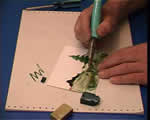 |
- place the brush tip gently onto the card as you start the upward stroke
|
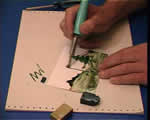 |
- keep the line of dark green wax heavy and vertical (parallel to the
card edge).
- at the top end of the vertical line lift the brush head off whilst
still moving so that a nice fine top spike is formed.
|
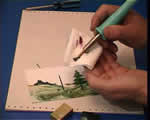 |
- clean the brush head by holding a tissue pad in your free hand and
placing the wire fibres carefully into this.
|
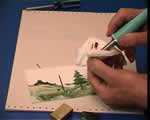 |
- always pull the brush head towards the stylus handle
- NEVER push the delicate wire brush forwards or the fibres will damage
|
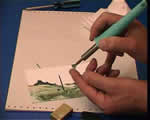 |
- the wire fibres should be free of ona another and can be carefully
seperated into a splayed fan shape to make finer strokes possible -
a damaged brush head will not allow this
|
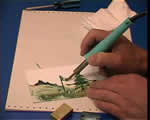 |
- with no wax loaded onto the brush use the fanned out firbes to gently
remelt and tease the line of wax already deposited into the fir tree
branch forms
- no new wax is necessary at this stage, just carefully get the basic
tree shape formed
|
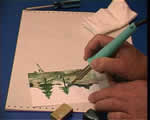 |
- for the second side it is often easier to turn the card upside down
and just mirror the form you have made on the first side.
|
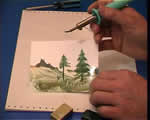 |
- continue to work down the tree form until it is completed - this
example has been stopped half way down because of time constraints in
making the video that has been used for the source of these step by
steps.
|
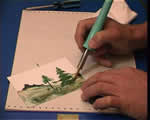 |
- now to add a more 3 dimensional feeling to the tree partially load
the end of the brush head firbres with a little wax and carefully dab
this in 'skirts' onto the existing tree structure - start at the top
and work down. the lower you go the more wax you will need to load onto
the brush.
|
 |
- You can see here that the 'skirts' add a more 3D effect, giving depth,
weight and shadow, especially compared with the original half done tree
which looks like it has been sawn down through the middle.
|
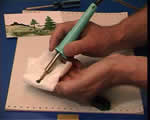 |
When you are finished or want toclean up the brush head to pristine
condition follow this procedure :
- start by wiping the head in a tissue pad as before
|
 |
- remember to always pull the brush head towards the stylus handle and
NEVER push the delicate wire brush forwards or it may damage the fibres
|
 |
- repeat this wiping process until there is no further trace of wax
dirt showing on the tissue
|
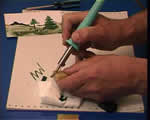 |
- next place the heel of the brass rod into some clear wax and allow
this to dribble down through the brush head and drip of onto the tissue
pad. The clean uncoloured wax will, in effect, wash out the 'dirty pigments'
that remain hidden in the wire fibres.
|
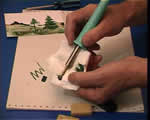 |
- again, wipe the newly cleaned head through a clean part of the tissue
pad. If there are still traces of dirt then repeat the clean wax process
again, but this is rarely necessary.
|
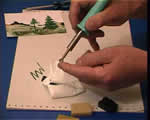 |
You can check the condition of your brush head by testing
to see if the fibres will seperate out into a fan shape. If they are
too tangled then this will not be possible.
The brush is very useful for
careful working and small internal areas of paintings, but equally it
can be used to create complete and large artwork in many interesting styles.
|









